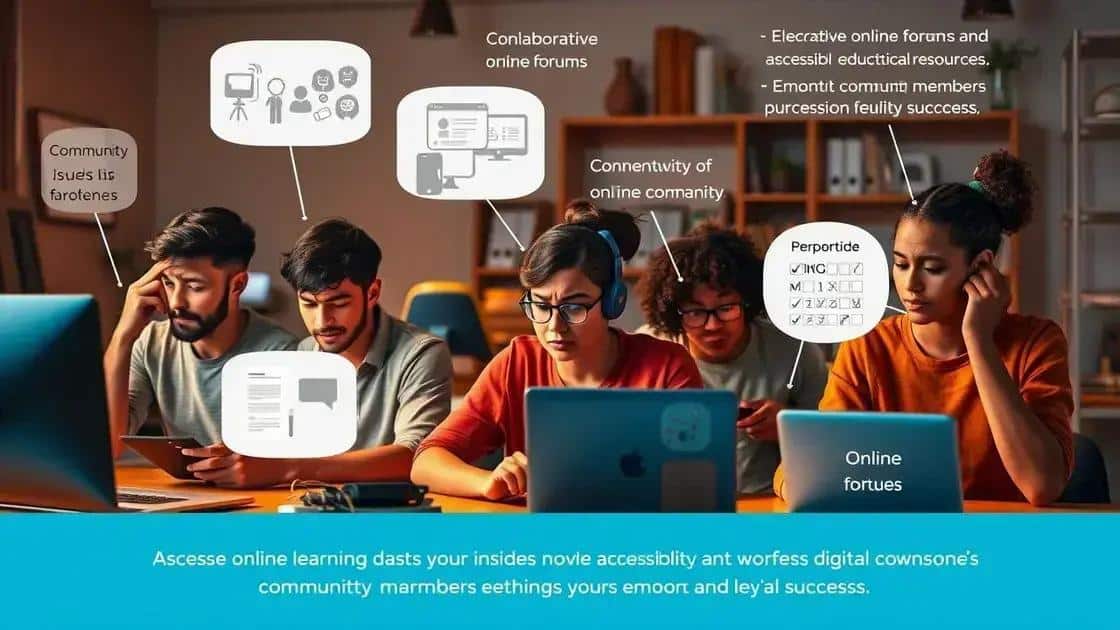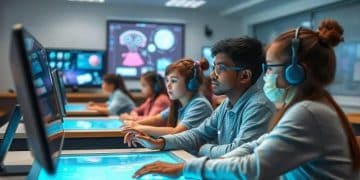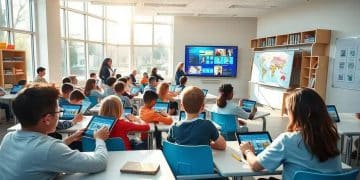Insights on remote learning platforms that boost engagement

Remote learning platforms face challenges such as technical issues, access disparities, and engagement difficulties, but solutions include improving technology, providing resources, and utilizing interactive teaching methods to enhance the online education experience.
Insights on remote learning platforms suggest they play a crucial role in shaping modern education. Have you ever wondered how these tools impact learning experiences? Let’s dive into their benefits and features.
Understanding the benefits of remote learning platforms
Remote learning platforms have transformed the way education is delivered today. By offering a wide variety of tools and resources, these platforms not only facilitate access to learning but also enhance the overall experience for students.
Key Advantages of Remote Learning
One significant advantage of remote learning platforms is the flexibility they provide. Students can learn at their own pace, fitting their education into their busy schedules. This flexibility allows for a more personalized learning experience, which is essential for student success.
Access to Resources
With remote learning, students have access to a plethora of digital resources. Online libraries, interactive tutorials, and forums are just a few examples of the tools available. These resources help students engage more deeply with the material.
- Instant access to various learning materials
- Availability of multimedia content enhancing learning
- Ability to review lessons at any time
This constant access to information fosters a sense of independence in students. They can explore topics that interest them outside of the standard curriculum. Moreover, remote learning environments often incorporate collaborative tools that promote peer interaction, vital for social skills development.
Engagement and Customization
Understanding the benefits of remote learning platforms also includes recognizing how they enhance engagement. Features such as interactive quizzes and discussion boards keep students involved. With the ability to customize their learning experience, students can choose what works best for them.
Additionally, instructors can track student progress in real-time. This tracking enables them to intervene promptly when a student struggles, making the learning process smoother and more effective.
Remote learning platforms not only enhance educational access but also provide an adaptable environment. Students learn to manage their time effectively and take responsibility for their learning. Overall, these platforms bridge the gap between conventional education and modern technological solutions.
Key features of effective online education tools
Effective online education tools provide unique features that enhance learning experiences. These features are designed to cater to various learning styles and ensure student engagement. Understanding these tools is crucial for both educators and learners.
User-Friendly Interface
A key feature of effective online education tools is their user-friendly interface. A simple and intuitive design allows students to navigate without frustration. This ease of use encourages regular interaction with the platform.
Interactive Learning Elements
Another significant characteristic is the inclusion of interactive learning elements. Features like quizzes and interactive videos keep learners engaged and make the content more memorable. Incorporating multimedia resources can enhance understanding and retention.
- Interactive quizzes that provide immediate feedback
- Discussion forums to encourage student collaboration
- Assessment tools for tracking progress
Additionally, many online tools offer gamification elements, such as badges and rewards, to motivate students. These aspects create a fun learning environment, promoting competition and collaboration.
Accessibility Across Devices
Accessibility is vital for effective online education tools. They should be compatible with various devices, allowing learners to access content from smartphones, tablets, and computers. This flexibility ensures that education can occur anytime and anywhere.
Moreover, incorporating features like screen readers and adjustable text sizes can make learning more inclusive for students with disabilities. By addressing individual needs, these tools contribute to a more equitable learning experience.
The ability to integrate with other educational resources, such as learning management systems (LMS), also enhances usability. Integrations help in streamlining administration and course management, resulting in a more efficient learning experience.
Best practices for engaging students in virtual classrooms
Engaging students in virtual classrooms is essential for effective online education. Implementing best practices ensures that learners remain focused and motivated throughout their courses. Various strategies can enhance student interaction and connection.
Utilize Interactive Tools
Interactive tools play a vital role in keeping students engaged. Platforms that offer features like polls, quizzes, and breakout rooms encourage active participation. These elements foster discussion and collaboration among peers.
Encourage Collaboration
Another effective practice is promoting collaboration. Students can work together on projects or assignments, which builds a sense of community. Group activities can make online learning feel more personal and engaging.
- Creating small group discussions to foster peer interaction
- Using collaborative tools like shared documents
- Incorporating peer reviews to enhance learning
Additionally, leveraging social media for class discussions can make the experience more relatable for students. This approach allows them to connect and share ideas outside of formal class settings.
Establish Clear Communication
Clear communication is crucial in a virtual classroom. Setting expectations for participation and availability helps students know when and how they can engage. Regularly updating students through emails or forum posts keeps them informed and connected.
Building rapport with students is equally important. Encouraging them to share their thoughts and experiences creates an open atmosphere. Providing timely feedback on assignments also encourages continued participation, as students feel valued and acknowledged.
Challenges faced by remote learning platforms and solutions

Remote learning platforms face a variety of challenges that can impact the effectiveness of online education. Understanding these challenges is important for improving the overall learning experience.
Technical Issues
One of the primary challenges is technical difficulties. Students may experience problems like slow internet connections or platform crashes. These issues can disrupt lessons and hinder participation.
Access and Equity
Access and equity are crucial factors in remote learning. Not all students have reliable internet or device access, which creates disparities in learning opportunities. This inequality can leave some students behind.
- Solutions include providing low-cost internet options
- Offering device lending programs
- Creating offline learning materials for students without internet access
Additionally, schools can collaborate with community organizations to provide resources and support. Ensuring that all students have the tools they need is vital to their success.
Engagement and Motivation
Keeping students engaged can be another hurdle. Virtual classrooms often lack the immediate interaction found in physical settings, making it harder to maintain student focus. Many students struggle with motivation when learning online.
To mitigate these issues, educators can use engaging strategies to promote active participation. Techniques such as gamification and interactive activities can help retain student interest. Additionally, fostering a supportive community encourages students to connect with one another and feel more involved.
Training teachers in online engagement strategies can also enhance learning experiences. Providing professional development on effective remote teaching will help them adapt to this environment.
FAQ – Common Questions about Remote Learning Platforms
What are the main challenges faced by remote learning platforms?
The main challenges include technical issues, access disparities among students, and maintaining engagement in a virtual environment.
How can technical issues in remote learning be resolved?
Improving technology infrastructure, ensuring reliable internet access, and providing tech support can help resolve technical issues.
What strategies can be used to keep students engaged in virtual classrooms?
Using interactive tools, promoting collaboration, and incorporating gamification are effective strategies to maintain student engagement.
How can we ensure equitable access to remote learning?
Providing resources such as devices and low-cost internet options, as well as creating offline materials, can help ensure equitable access.





